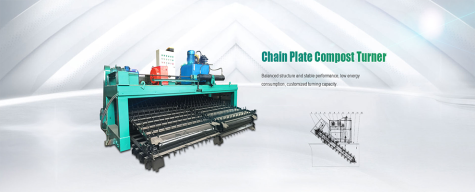Chain plate compost turner speeds up the decomposition process of organic waste. It is easy to operate and has great efficiency, so this composting equipment is widely used not only in organic fertilizer manufacturing plant, but also in farm composting.
Inspection before conducting a test run
◇ Check whether the reductor and lubrication points have been lubricated sufficiently.
◇ Check the voltage of power supply. Rated voltage: 380v, pressure drop should no less than 15% (320v), no higher than 5% (400v). Once beyond this range, driving is not allowed.
◇ Check whether the connections of motor and electrical components is secure, and grounding the motor with wires to ensure safety.
◇ Check whether all joints and connecting bolts are rigid. Please tighten if they are loose.
◇ Check the pile height.
Conducting the Test Run without Load
Putting the composting equipment into operation. Stop the compost turner immediately once the rotational direction is reversed, then change the turning direction of three-phase circuit connection. During operation, listen whether the reducer has unusual sound, touch bearing’s temperature to inspect whether it is in the temperature range, and observing whether there is friction between helical mixing blade and ground surface.
Test Running with Load
① Start the compost windrow turner and hydraulic pump. Putting the chain plate slowly to the bottom of fermentation tank, adjusting the position of chain plate according to the flatness of ground: keep the compost turner blades 30mm above the ground once the integrated error of ground level less than 15mm. If higher than 15mm, those blades can only keep 50mm above the ground. During composting, when the blades hit the ground, lifting the chain plate to avoid damage to compost turner equipment.
② During the whole test run process, check composting equipment transmissions promptly once there is unusual sound.
③ Check whether the electric control system works stably.
Attention Matters in Chain plate Compost Turner Operation
Personnel should stay far away from the composting equipment, to prevent accidents. Looking around the compost turner before put it into operation.
▽ In production, maintenance and filling of lubricant oil is not allowed.
▽ Operating in strictly accordance with prescribed procedures. It is strictly prohibited to work in the opposite direction.
▽ Unskilled operators are not allowed to operate the machine. On conditions of drinking alcohol, physical discomfort or bad rest, operators should not operate the helix compost turner.
▽ All tracks of the windrow turner should be grounded for the purpose of security.
▽ The power must be cut off when replacing the slot or cable
▽ Attention must be paid to observe and prevent the hydraulic cylinder too low to damage the turning paddles when positioning the chain plate.
Maintenance
Inspection items before driving
●Check whether all fasteners are secure, and if the chain plate clearance of transmission components is appropriate. Inappropriate clearance should be adjusted in time.
● Butter the axle-bearings and check the oil level of gearbox and hydraulic tank.
● Make sure the wire connections are secure.
Downtime maintenance
◇ Removing residues on the machine and surrounding area
◇ Lubricating all lubrication points
◇ Cutting off power supply
Weekly maintenance items
● To check the gearbox oil and add enough gear oil.
● To check the contacts of control cabinet contactor. If damaged, replace immediately.
● To check the oil level of hydraulic box, and sealing condition of connections of oil channels. Replacing seals timely if oil leaks.
Periodic inspection items
◇ Checking the operating conditions of motor reducer. If there is any abnormal noise, or heating, stop and check the machine immediately.
◇ Checking the bearings for wear. Badly worn bearings should be replaced.
Common Problems and Troubleshooting Methods
|
Failure Phenomenon |
Failure Causes |
Troubleshooting Methods |
|
Turning Difficulty |
Raw material layers being too thick | Removing superfluous layers |
|
Turning Difficulty |
Shafts and blades severely deformed |
Fixing blades and shafts |
|
Turning Difficulty |
The gear damaged or being stuck by foreign bodies |
Excluding foreign body or replacing the gear. |
|
Walking isn’t smooth, reducer with noise or fever |
There are other matters on the walking cable |
Cleaning the other matters |
|
Walking isn’t smooth, reducer with noise or high temperature |
Lack of lubricating oil |
Adding lubricating oil |
|
Difficulty or failure in staring the motor, accompanying by buzzing |
Excessive wear or damage on bearings |
Replacing bearings |
|
Difficulty or failure in staring the motor, accompanying by buzzing |
Gear shaft becoming deflection or bending |
Removing or replacing a new shaft |
|
Difficulty or failure in staring the motor, accompanying by buzzing |
Voltage being too low or too high |
Restarting the compost turner after voltage is normal |
|
Difficulty or failure in staring the motor, accompanying by buzzing |
Reducer oil shortage or damages |
Checking the reducer to see what happens |
|
The composting equipment cannot run automatically |
Checking whether the electric circuit is normal |
Fastening each connections |
Post time: Jun-18-2021


